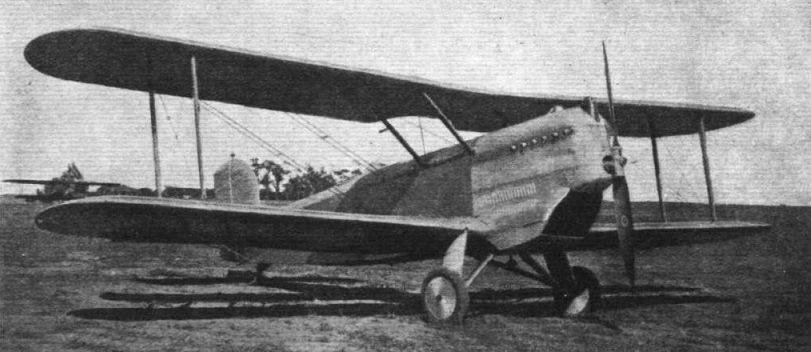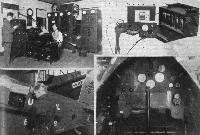
Варианты
- Douglas - O-2 / BT - 1924 - США
- Douglas - M-1 - M-4 - 1925 - США
- Thomas-Morse - O-19 - 1929 - США
Серия самолетов Douglas M
С 1918 года почтовому ведомству США поручили создать систему воздушного почтового сообщения. В 1925 году ведомство решило, что различные типы биплана DH-4, являвшиеся на тот момент основными перевозчиками авиапочты, сильно износились. Поэтому было принято решение заказать почтовую версию военного самолета-разведчика Douglas O-2. Эта машина DAM-1 (Douglas Air Mail no.1 - самолет №1 фирмы "Douglas" для авиапочты), вскоре название сократили до M-1, прошла летные испытания весной 1925 года. Машина имела вдвое большую полезную нагрузку, чем DH-4, хотя оснащалась все тем же проверенным, легкодоступным и относительно дешевым мотором Liberty. Биплан M-1 фактически стал простой переделкой машины O-2 с закрытой алюминиевым колпаком передней кабиной для образования почтового отделения с доступом через два люка. Пилот сидел в задней кабине, в которой на O-2 размещался наблюдатель. В ходе испытаний установили удлиненный коллектор выхлопных газов для их выброса подальше от пилота. M-1 посчитали удачным, но фирма "Douglas" не получила заказов на их серийный выпуск.
Однако с введением авиалиний контрактной авиапочты (САМ) компания "Western Air Express" (позднее "Western Airlines"), незадолго до этого основанная, все же заказала шесть почтовых бипланов Douglas. Самолеты с обозначением M-2 отличались от M-1 главным образом использованием лобового радиатора вместо первоначального радиатора туннельного типа. Также была введена возможность быстрой переделки грузового отсека в отсек для перевозки пассажира. За месяц до того, как в апреле 1926 года компания "Western Air Express" открыла авиалинию Лос-Анджелес - Солт-Лейк-Сити, почта США заказала 50 машин версии M-3 для своих основных маршрутов.
После этого главный инженер компании "Douglas" Дж. Киндлбергер переделал проект M-3 для увеличения его полезной нагрузки. Главным новшеством в этом биплане, названном M-4, стало новое удлиненное крыло. На нем также отсутствовал вырез в задней кромке верхнего крыла, унаследованный от O-2. Почтовое ведомство потребовало, чтобы из 50 заказанных им самолетов M-3, 40 машин были поставлены в конфигурации M-4. Один купленный компанией "Western Air Express" M-4 фирма "Douglas" обозначила M-4A, чтобы отличить его от самолетов, заказанных почтовым ведомством. В октябре 1925 года компания "National AirTransport" (NAT) взяла в аренду трассу CAM-8, соединившую Даллас и Чикаго, после чего у нее возникла необходимость в большом количестве почтовых самолетов. Компания NAT сначала использовала машины Curtiss Carrier Pigeon. Затем, приобретя важный маршрут, связывающий Чикаго и Нью-Йорк, она в июле 1926 года купила все 10 бипланов M-3 и восемь M-4, выставленных на аукцион почтовой службой. С 1 сентября 1927 года NAT начала их применение. В 1930 году она списала эти машины, заменив их трехмоторными самолетами Ford Trimotor. За три года службы почтовые самолеты Douglas превосходно летали и в самых трудных погодных условиях. Компания NAT покупала и другие M-4 в ряде мест. Одновременно в ее парке числилось до 24 почтовых самолетов фирмы "Douglas".
Среди самолетов был частный биплан, конфискованный казначейством США при незаконной контрабанде спиртного с Кубы во Флориду во времена "сухого закона". Он прославился под именем "Booze Ship". С весны 1928 года бипланы М-3 компании летали с новыми крыльями увеличенного размаха. Из соображений экономии они были разработаны и собраны собственным техническим отделом компании. NAT также переделала один биплан M-4 под звездообразный мотор Pratt & Whitney Hornet С мощностью 525 л.с. (391 кВт).
Всего собрали 57 почтовых самолетов Douglas, но с появлением самолетов Ford и других мощных трехмоторных машин их карьере пришел конец. Несколько самолетов продали частным владельцам, но большую часть сдали на слом. В 1956 году компания "Western Airlines" на свой 30-летний юбилей восстановила один чудом уцелевший биплан M-4 с увеличенным размахом крыльев до летного состояния в подлинной раскраске из красного и серебристого цветов.
ТАКТИКО-ТЕХНИЧЕСКИЕ ХАРАКТЕРИСТИКИ
Douglas M-4
Тип: одноместный почтовый самолет
Силовая установка: V-образный поршневой мотор Liberty 12 мощностью 400 л. с. (298 кВт)
Летные характеристики: максимальная скорость 225 км/ч на уровне моря; крейсерская скорость 177 км/ч на оптимальной высоте; начальная скороподъемность 305 м/мин; практический потолок 5030 м; дальность полета 1127 км
Масса: пустого самолета 1544 кг; максимальная взлетная 2223 кг
Размеры: размах крыльев 13,56 м; длина 8,81 м; высота 3,07 м; площадь крыльев 38,18 м2
Полезная нагрузка: до 454 кг почты
Описание:
- Серия самолетов Douglas M
- Flight, November 1925
THE DOUGLAS D.A.M.2 BIPLANE
Фотографии
-
Flight 1925-12 / Flight
THE DOUGLAS "D.A.M.-2" MAIL 'PLANE: A three-quarter front view of one of the recent machines produced in America for air mail service.
-
Flight 1925-12 / Flight
THE DOUGLAS "D.A.M.-2" MAIL PLANE. Side view. A 400 h.p. "Liberty-12" engine is installed.
-
Flight 1925-12 / Flight
A front view of the Douglas "D.A.M.-2" mail 'plane, showing the thickened wing-roots on the lower plane where the petrol tanks are located.
-
Flight 1926-07 / Flight
U.S. AIR MAIL SERVICES. C.A.M. NO.4: One of six Douglas M.2 mail 'planes employed by the Western Air Express, Inc., on the Salt Lake City to Los Angeles route.
-
Мировая Авиация 63
17 апреля 1926г.: Маури Грэхэм начал на Douglas М-2 авиапочтовые перевозки компании "Western Air Express" между Лос-Анджелесом и Солт-Лейк-Сити.
-
Мировая Авиация 115
На самолетах M-3 были введены упрощенная схема расчалок, переделанная силовая установка и улучшенное оборудование для ночных полетов.
-
Flight 1929-06 / Flight
W. L. Smith, the veteran pilot, and Superintendent of the Eastern Division of N.A.T. air lines, who made a successful test of the directional, or radio beacon apparatus, during which he flew in dense fog and rain, in spite of which he was at all times in close touch with the airport, and landed safely.
-
Flight 1929-06 / Flight
US. AIR MAILS AND WIRELESS: (1) The interior of the radio airway broadcasting station of N.A.T. air services. Here weather reports and other information are received over the teletype and broadcast to the Pilots In flight. (2) Radio equipment for mail and express plane, showing pilot s helmet and earphones, the switchboard, the receiving set and battery. (3) The set is installed in the fuselage aft of the pilot's cockpit, from where it is operated by remote control shown in (4), the switchboard being located on the left.
-
Мировая Авиация 115
Компания "National Air Transport" заказала биплан M-4S - финальную модель M-4. Он имел кабину для трех человек и звездообразный мотор Wasp.
- Фотографии












